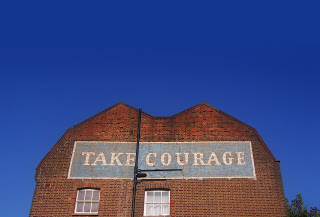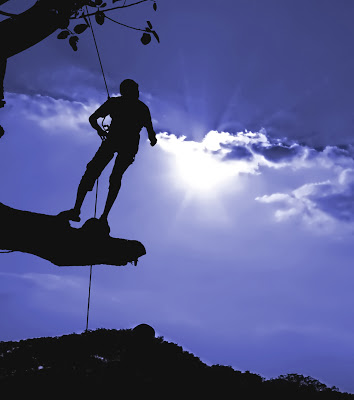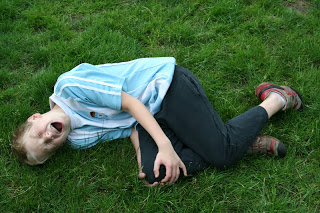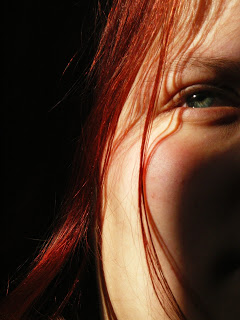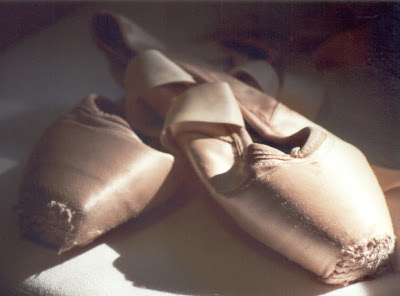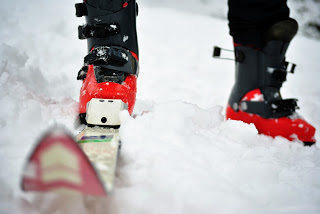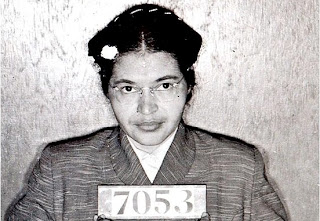A couple of years ago, Jennifer, my husband and I took our kids to a ropes course called Adirondack Extreme. It is described as an “Aerial Tree Top Adventure” which includes a complex ropes course suspended between trees at 10 to 60 feet off the ground. It promised to be a fun physical courage challenge. Little did I know that it would be more of an emotional and social courage challenge for me. The labyrinth of ropes wouldn’t prove to be my biggest adversary, but untangling myself from my own perfectionism would be.
Jennifer did not climb due to an old injury, but she supervised our daughters on the kids’ course. My husband, our son, and I challenged the adult course. We attended a brief instruction on how to put on our harness, how to securely hook and unhook ourselves along the course, and how to ask for help—if push came to shove and we decided we were done at some point along the increasingly challenging course. I paid pretty close attention to the introductory talk, but only half-listened to the “asking for help” part. As I’ve written about previously in my post “Quitters, Campers, and Climbers,” I’m not much of a quitter. I’m a climber who, I’m embarrassed to admit, even sometimes secretly feels superior to quitters.
By the time I reached mid-course, my then 12-year old son was lapping me. He seemed recklessly, blissfully unaware of all the risks that I was quickly becoming aware of as I looked down from the tree tops to the ground twenty, then fifty, feet below. He just kept saying “Mom, this is SO much fun. It’s easy!”
I can assure you this course was NOT easy! And I was so over the idea of this being fun. The more joyless and humorless I became, the more rigid my body became. My joyful son, on the other hand, had the agility of a monkey; while I swung precariously, holding on for dear life with increasingly sweaty palms, between the various rope mazes. He was fearless, while I was quickly becoming fearful.
One of the big differences between kids and adults in terms of risk assessment is the cognitive tricks that our minds begin to play with us as we develop. According to child psychologist Dr. Tamar Chansky (2004), in her book Freeing Your Child from Anxiety: Powerful, Practical solutions to Overcome Your Child’s Fears, Worries, and Phobias, we feel anxious when we begin to confuse the possibility of occurrence with the probability of it actually occurring. Dr. Chansky writes that the “Anxious Response= Overestimation of Threat + Underestimation of Ability to Cope.” So, while I was focusing on whether or not the ropes were strong enough to hold me, the possibility of falling, how painful it would be to hang upside down for an extended period of time waiting for help, whether or not my children (who I no longer had in sight) were okay or not, and how embarrassing it would be to quit; my son was enjoying each new obstacle on the course while feeling totally secure in his crotch harness and physical ability.
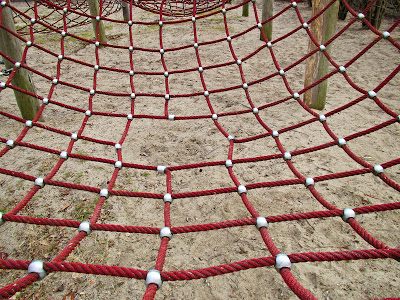
At the second to last level, all alone now on the course, I was officially scared. But quit? OMG, no way! Quitting = Failure, to the perfectionist mind. Which is, as Jennifer wrote in her last post Failure is Always an Option, “tantamount to total annihilation.” At the very least, annihilation of the ego. Success for me, at times, can be deeply intertwined with trying to prove that I’m lovable and valuable. In short, I wasn’t a kid who learned that her success in life is based on who she is, not on how she looks or what or how well she does. A perfectionist places more value on how she appears to the world than on who she is on the inside. This misplacement of her inherent value creates a fragile ego swinging precariously from one success to the next, desperately trying to avoid the identity-crisis pitfalls that mistakes, and especially failure, threaten. It’s also what makes perfectionists highly competitive and probably not all that relaxing to be around sometimes. Needless to say, this aspect of my personality is not particularly healthy–nor is feeling secretly superior to quitters, for that matter! These are not personality characteristics I wish to pass along to my children. Instead, I parent my kids in ways that focus on their inherent value. I focus less on how they look and what grades they get, but more on the core qualities they are developing as kind, loving human beings. I encourage them to listen to their limits and feelings, to focus on their successes, to identify goals that are truly important to them (not society at large), to do their best because there is no such thing as perfect, and to be gentle with themselves when they make mistakes. I’ve coached them to develop an internal locus of control (you can read my parenting tips here: Are You an Inny or an Outy?) And I’m known for saying “I love who you are, and who you are becoming.” Let’s be honest, embracing this kind of unconditional acceptance of both ourselves and our children is kind of radical—especially today in our culture of overachievement! Dr. Brene Brown’s book The Gifts of Imperfection is a great resource for anyone interested in understanding and letting go perfectionism!
One of the many gifts of being a parent, in my opinion, is that we get the chance to teach (and learn from) our kids what we, too, need to learn in life. In essence, parenting has given me the opportunity to release myself from perfectionism’s uncomfortable grip and develop the kind of self-acceptance and love that my kids seem to instinctively possess. And now I was about to model that it’s sometimes okay to quit!
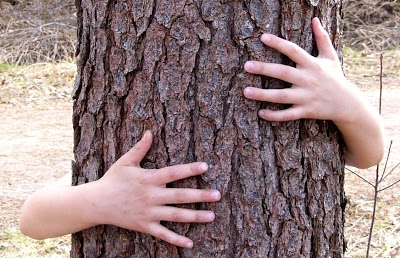
When I reached the next tree post, I found myself hugging and not wanting to let go of that tree with the kind of intense love usually reserved for extreme environmentalists. I was done! It was suddenly much more important to me to listen to my body’s limits and find my kids on the course than to prove to myself and others that I could finish. Suddenly, quitting was not only an option, but it was okay. I couldn’t remember the code word the guide had told me to yell if I needed to be rescued, but in any situation screaming “HELP!” usually works. I started with a timid “Helloooooo. Guide?!” which quickly progressed to screaming above the treetops “HELP! I need to get down now.”
In a matter of minutes, a very kind and capable young man arrived on the scene to lower me from the towering heights of my new BFF. I told him I was okay and felt surprisingly calm. I wanted to reassure him that I wasn’t going to cling to him like a crazy lady when he finally reached me. He, in turn, reassured me that this kind of thing happens every day. That made me feel a lot better! I found myself laughing, recalling my high-pitched screams for help above the tree tops, and relaxing as he lowered us to the ground. I was amazed not to be embarrassed. The earth did not open up to swallow me whole when my feet reached terra firma. Throngs of people weren’t waiting on the ground to laugh, jeer, and otherwise poke fun at my failure. These are the kinds of thoughts that keep perfectionism well-fed, by the way, and keep us from trying things that might mean risking failure in some way, shape, or form. In fact, I felt kind of proud of myself. I had actually asked for help and received it! Trust me when I say, it took more emotional courage for me to quit, ask for help and trust that it would arrive, and social courage to risk embarrassment amongst my peers and family, than the physical courage to force myself to finish the course.
I could have focused on my failure and spiraled down into an abyss of low self-esteem, but I made my failure okay by focusing instead on what I was able to accomplish. I made it okay to quit by untangling who I am as a person from my perfectionist expectations. I discovered that the belief that you are already “good enough,” no matter what you are able to accomplish, is perfectionism’s personal kryptonite. Adopting a new respect for quitting has also freed me up to be willing to climb again!
By honoring the type of courage I actually needed to develop, I was able to reframe my perceived physical courage “failure” as an emotional courage accomplishment. We can do this for our kids, too, by helping them to recognize the gains they make everyday, by breaking apart difficult tasks into smaller more manageable and achievable ones, and by celebrating their successes. We can help them identify which of the six types of courage they are developing, and are capable of, in everything they do!
As I was writing this post, I asked my daughter to define failure. Her answer: “There is no such thing as failure Mom. Whatever you are able to do is okay.” When I also asked if she’d like to try the adult course with me again this summer, now that she’s almost 12, she said: “Probably not. I’m not a big fan of heights.”
You can read more about coaching kids to face challenges in my previous post: Discourage/Encourage: What’s a Parent to Do?
 This story, Issun-Boshi the Inchling, or the Inch-High Samurai, is sometimes referred to as the Japanese Tom Thumb. It is a much loved story that reminds us that physical courage is not reserved for the big and strong among us.
This story, Issun-Boshi the Inchling, or the Inch-High Samurai, is sometimes referred to as the Japanese Tom Thumb. It is a much loved story that reminds us that physical courage is not reserved for the big and strong among us.  This story, Issun-Boshi the Inchling, or the Inch-High Samurai, is sometimes referred to as the Japanese Tom Thumb. It is a much loved story that reminds us that physical courage is not reserved for the big and strong among us.
This story, Issun-Boshi the Inchling, or the Inch-High Samurai, is sometimes referred to as the Japanese Tom Thumb. It is a much loved story that reminds us that physical courage is not reserved for the big and strong among us. 
